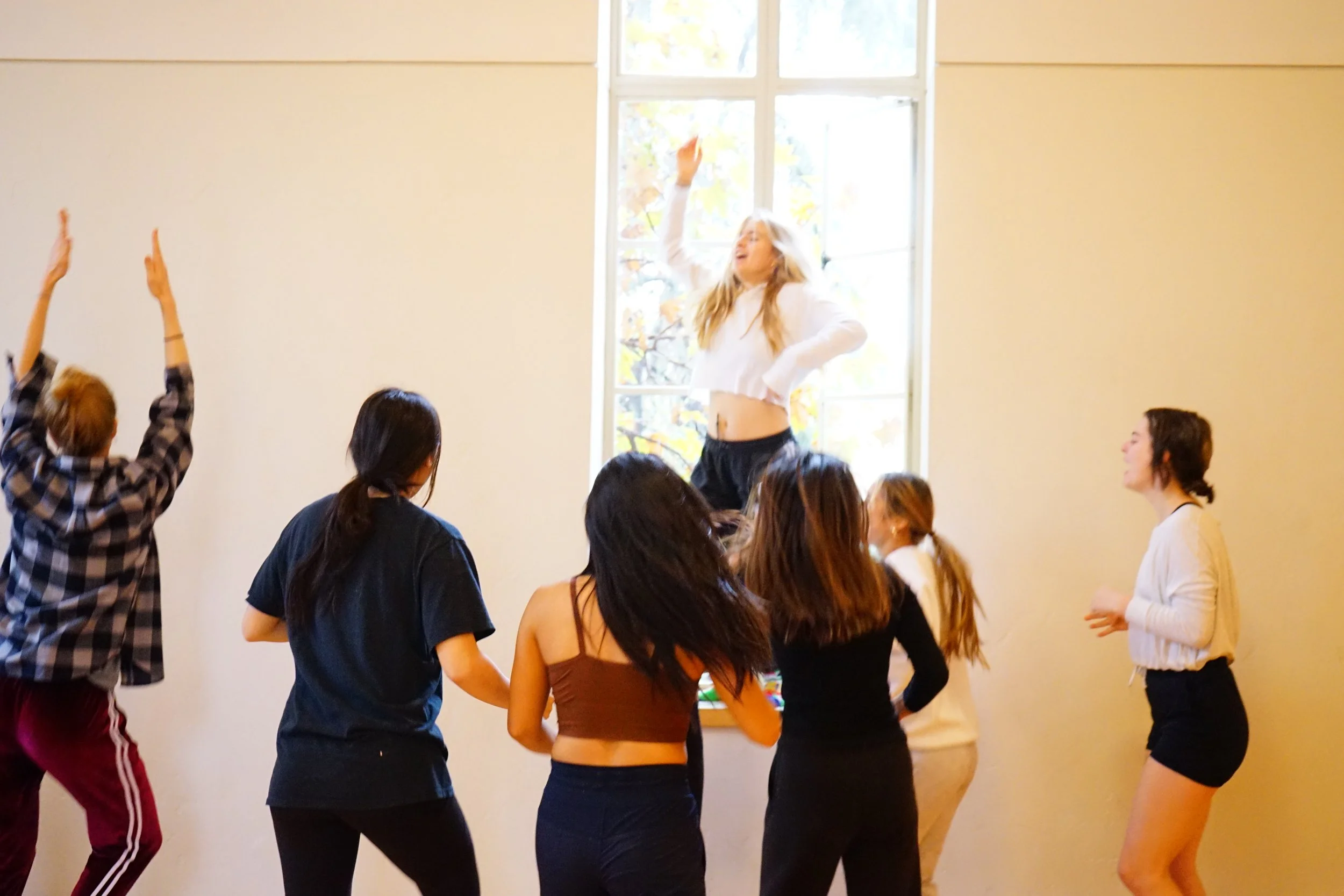teaching portfolio
photo: Justin Gamboa
Introduction to Improvisation
This undergraduate studio course offers an introduction to dance improvisation and develops upon students’ skills for dancing in solo, duet, and ensemble formats. In this class, we consider how improvisation takes place across a range of different dance forms and is crucial to the way we navigate situations in our everyday lives. While improvisation notoriously happens in the “present moment,” there are many different improvisational traditions that reflect unique cultural histories and lineages. Some of the systems we will experience together in class are: contact improvisation, capoeira, cyphering, contemplative dance practice, Improvisation Technologies (William Forsythe) and other approaches to building composition in real time. In each class, we will spend most of our time moving and watching others move. Can we sharpen our powers of perception in order to make satisfying decisions from within the dance, as it unfolds around us? What are some approaches to generating movement material in the moment? How do we enter into and have impact on dances that are already happening? How do our actions relate to other elements in the room (music, environment, rhythm, space, other dancers)? How should we deal with the moments when we are at a loss for what to do next? Over the quarter, we will assemble an adaptable toolkit that will help us tackle these challenges.
photo: Justin Gamboa
critical approaches to choreography
What do we “perform” when we dance? How can we investigate a dance in terms of the values systems it promotes? How do different dance movements, techniques, styles, and vocabularies signify, negotiate, or subvert social norms? How do they create relationships with others? What is at stake in these choreographies? This undergraduate dance major course aims to develop “critical” awareness of dance and choreography. The term “critical,” as we will use it, is different from “criticizing” or pointing out the flaws of something. Instead, we will define “critical” as an approach that reflects on how dances interact with their broader social and cultural contexts. We will pay special attention to the power structures that inform how one creates and derives meaning from dances and dancing. We will use a variety of methods including reading, writing, discussion, and dance making to cultivate this awareness. In all of these, we will approach dance making as the articulation of a particular point of view or way of being—an exercise in which social ideas are embedded and expressed through our bodily actions and postures. We will consider how social structures, such as race, gender, class, sexuality, nation, religion, age, and ability shape our understandings of dancing bodies, dances, and choreography—including what constitutes “dance and choreography.”
photo: André Andreev
Contact Improvisation / contemporary partnering Techniques
This course open level will provide an introduction to Contact Improvisation, a framework for improvised dancing with one or more partners while using a moving point or points of physical contact, supporting and sharing weight, rolling, sliding, suspending, falling, recovering, and more. Throughout the course, we will hone our abilities to track gravitational force as it moves through our own bodies and the bodies of our dance partners. We will use this awareness to enhance our capacity to safely collaborate with this force in spontaneous dances that balance autonomy and collaboration. We will contextualize our practice through readings, viewings, and discussions that address social/political/historical aspects of CI as a form. We will also practice writing about our kinesthetic experiences as an opportunity to harvest and preserve insights that will support our growth as dancers and thinkers. While this class presumes an openness to physical touch, all touch in this class is optional. Detailed consent protocols will be integrated within our work together. Modifications will be provided for students who do not wish to touch on any given day, no questions asked.
image: The Classic Ballet
Ballet Technique
This open level course offers an approach to ballet as a technique for moving fully, safely, and with confidence through space. Learning will be practice-based and will focus on key principles of ballet technique such as dynamic alignment, working in turnout (outward rotation of the hips and legs), moving with precision and mindfulness, and using the ground and gravity to sustain upward and airborne movement. Each class will include exercises at the barre and movements in the “center” (away from the barre). We will supplement our ballet practice with conditioning sessions and discussions about the social, political, and historical contexts that shaped ballet as an expressive form. Throughout the quarter, we will consider ballet as a physical and aesthetic language grounded in geometric principles, as well as a cultural form that has evolved over time.
photo: Justin Gamboa
research seminar: Attention in Action: Dance, Perspective, and Experience
How do our habits of attention affect the way(s) we move? How do our specific ways of moving determine what we notice? Can improvised dancing provide a platform for researching connections between action and experience? In this hybrid studio/seminar course, we will engage these questions through a hybrid approach that combines (a) discussion of key theories of perception from cultural studies, critical theory, philosophy, and cognitive science, and (b) participation in selected dance improvisation practices that purposefully modify how the dancer utilizes their perceptual abilities as a means of determining how they move. Ultimately, our aim is to foreground how choreographic scores can be used as research methods that might enrich or complicate methods from other disciplines. The major assignment for this course is to design and implement a mentored research project that integrates practice-based research with historical and cultural analysis. This course is open to graduate and upper division undergraduate students of any major.




